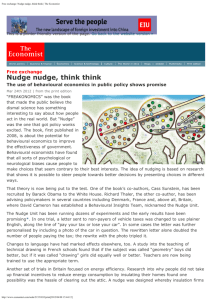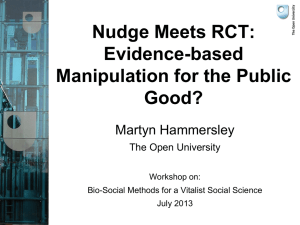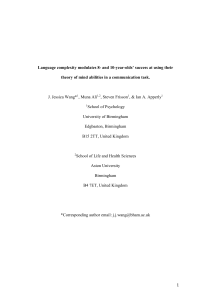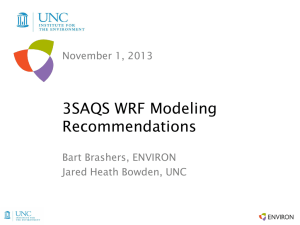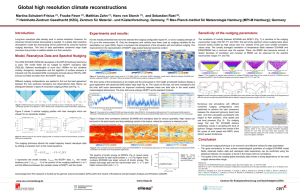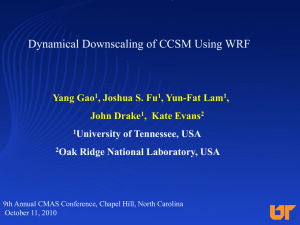The Effects of Grid Nudging on Polar WRF Forecasts in Antarctica
advertisement
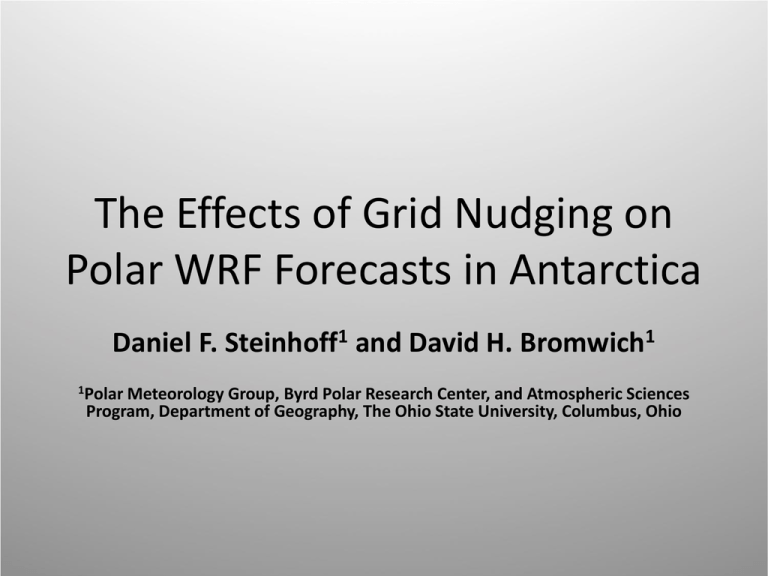
The Effects of Grid Nudging on Polar WRF Forecasts in Antarctica Daniel F. Steinhoff1 and David H. Bromwich1 1Polar Meteorology Group, Byrd Polar Research Center, and Atmospheric Sciences Program, Department of Geography, The Ohio State University, Columbus, Ohio “You’re the Inspiration” • During my visits to the McMurdo forecasting office, it was clear that AMPS forecasts beyond 72 hours are not well trusted – 72-120 hours: Events generally “pushed back” in time in subsequent forecasts – Only taken seriously inside of 72 hours Last Year • Aaron Wilson from our group found that grid nudging of Polar WRF simulations in the Arctic improves extended simulations compared to non-nudged simulations. • Are similar improvements possible in the Antarctic? Can AMPS forecasts out to 120 hours be more trustworthy? Grid Nudging • Grid nudging involves an extra time tendency term in the forcing equation for a given variable • This extra term “nudges” the tendency term towards the driving analysis/forecast, weighted by a representative time scale parameter • Originally designed for dynamic initialization of forecasts, but also useful during simulations Testing Strategy • Testing Simulations – Forced by NCEP GFS 1.0° forecasts – NUDGE: 120 hour simulation, nudged for top 5 model vertical levels only – NONUDGE: Same except no nudging • Validation Simulation – Forced by NCEP FNL 1.0° analyses – 48 hour simulations, reinitialized every 24 hours • So we compare the GFS-forced NUDGE and NONUDGE runs (24-120 hours) with FNL-forced “validation runs” (24-48 hours) at corresponding times Testing Strategy (Cont’d) • September – November 2009 • Testing simulations initialized at 0000 UTC on the 5th, 10th, 15th, 20th, 25th, and 30th of each month (Total of 18 cases) • Average verification statistics for each forecast hour from 24-120 hours computed (first 24 hours of each simulation discarded for model “spin-up” Model Settings • Polar WRF 3.1.1 • Identical 20 km domain to previous AMPS domain 2 • MP: WSM5 • SW, LW: RRTMG • Surface, PBL: MYNN • LSM: Noah Domain average statistics - PSFC • Biases rapidly increase after 72 hours, as do NUDGE and NONUDGE differences • Small differences between RMSE Domain average statistics – Z500 • 500 hPa geopotential height statistics similar to PSFC Anomaly Correlations - PSFC Forecast Hour NUDGE NONUDGE 24 0.99 0.99 30 0.99 0.99 36 0.99 0.99 42 0.98 0.98 48 0.95 0.95 54 0.94 0.94 60 0.93 0.93 66 0.92 0.92 72 0.90 0.89 78 0.87 0.87 84 0.85 0.84 90 0.82 0.82 96 0.80 0.80 102 0.78 0.78 108 0.76 0.76 114 0.73 0.72 120 0.68 0.68 Bias at 120 hours NUDGE NONUDGE RMSE at 120 hours NUDGE NONUDGE RMSE Differences - PSFC BLUE: NUDGE BETTER RED: NUDGE WORSE • Surface pressure: Scattered differences over ocean, but large expanse of lower RMSE over Antarctica for NUDGE RMSE Differences – Z500 BLUE: NUDGE BETTER RED: NUDGE WORSE • 500 hPa geopotential height: Scattered differences over ocean, but large expanse of lower RMSE over Antarctica for NUDGE RMSE Differences – T2 BLUE: NUDGE BETTER RED: NUDGE WORSE • 2 m air temperature: No discernible pattern RMSE Differences – q850 BLUE: NUDGE BETTER RED: NUDGE WORSE • 850 hPa mixing ratio: No discernible pattern Antarctic Land Only - PSFC • Taking only the land points: – Bias and RMSE differences larger in a relative sense than for entire grid Ocean Only - PSFC • Taking only the sea points: – Bias smaller, RMSE larger than land – Biases remain constrained longer (almost 96 hours) – Smaller RMSE differences than land Conclusions • Grid nudging improves verification statistics presented here – Small improvements on grid average, but greater improvements over Antarctic land – Grid nudging can help/hurt over certain ocean areas (likely placement of synoptic-scale cyclones) • More work needed: – Determine causality of changes to forecasts by nudging over both Antarctica and Southern Ocean – Verification against station and AWS observations

